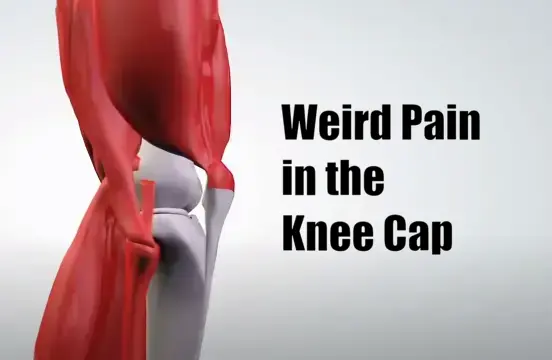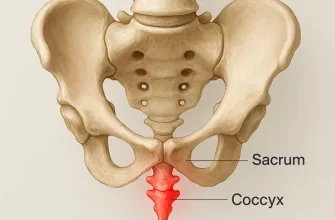Having a weird pain in your knee cap can be both alarming and uncomfortable. While many of us might attribute it to overuse or a sudden injury, there are several unexpected causes that can lead to this peculiar discomfort in the knees.
Causes
Let’s explore five factors that could contribute to the weird pain you’re experiencing:
- Improper Footwear: Believe it or not, your choice of footwear can significantly impact your knee health. Wearing shoes with insufficient support or inadequate cushioning can disrupt the natural alignment of your feet, leading to abnormal stress on your knee cap. This misalignment can cause weird pains to radiate to the knee cap area, particularly during activities that involve repetitive motions such as running or jumping.
- Weak Muscles: Weak muscles in and around the knee can compromise its stability, making it more susceptible to pain and injury. If you neglect strength training exercises that target your quadriceps, hamstrings, and hip muscles, it can lead to imbalances and abnormal movement patterns. These imbalances put extra pressure on your knee cap, resulting in strange sensations or discomfort.
- Overpronation: Overpronation occurs when your foot rolls inward excessively while walking or running, causing the arch to flatten. This inward rolling can alter the alignment of your lower extremities, including the knee joint. Over time, this misalignment can cause weird pain in the knee cap and even lead to conditions like patellofemoral pain syndrome or iliotibial band syndrome.
- Obesity: Excess weight places additional stress on your joints, including the knee cap. If you are overweight or obese, the extra pounds can strain the structures in your knee, leading to pain or discomfort. This discomfort may feel unusual or weird due to the unusual distribution of pressure on the knee cap.
- Poor Posture: Maintaining poor posture, especially when sitting or standing for extended periods, can lead to knee pain. Slouching or leaning forward can disrupt the alignment of your spine, hips, and knees, creating abnormal stress on the knee cap. Over time, this can cause strange and uncomfortable sensations in the knee area.
Diagnosis
Experiencing knee cap pain can be frustrating and concerning, especially if it seems to come out of nowhere or doesn’t follow a typical pattern. To ensure you receive the appropriate treatment, it’s essential to undergo a comprehensive diagnostic assessment.
We will explore seven diagnostic procedures that can assist in identifying the underlying causes of your weird knee cap pain.
- Physical Examination:
A skilled healthcare provider will thoroughly examine your knee, paying attention to any visible signs of inflammation, tenderness, swelling, or misalignment. They may also check your range of motion, stability, and muscle strength to identify potential issues. - X-ray:
An X-ray can provide valuable information about your knee joint’s structure, such as fractures, dislocations, and degenerative changes. It helps diagnose conditions like osteoarthritis, fractures, and malalignment that may contribute to your knee cap pain. - MRI (Magnetic Resonance Imaging):
When X-rays fail to detect abnormalities, an MRI can be a useful diagnostic tool. This non-invasive procedure uses a magnetic field and radio waves to create detailed images of the soft tissues surrounding the knee joint, such as ligaments, tendons, and cartilage. It helps identify issues like ligament tears, meniscal tears, or patellar maltracking. - Ultrasound:
This imaging technique uses sound waves to produce real-time images of the internal structures of your knee. An ultrasound can help assess the tendons, ligaments, bursae, and soft tissues for inflammation, fluid accumulation, or abnormalities contributing to your knee cap pain. - Arthroscopy:
Arthroscopy involves inserting a small camera called an arthroscope into your knee joint through tiny incisions. It allows healthcare professionals to visualize and diagnose various knee conditions while simultaneously performing minor surgical procedures if necessary. Arthroscopy is often used when other imaging tests fail to identify the cause of the knee cap pain. - Bone Scan:
A bone scan is a nuclear medicine imaging technique that helps detect bone abnormalities. It involves injecting a small amount of a radioactive substance into your bloodstream, which accumulates in areas with abnormal bone turnover or increased blood flow. A bone scan can help diagnose causes such as stress fractures or bone infections that may contribute to your knee cap pain. - Blood Tests:
Blood tests are employed to rule out certain medical conditions that may cause or contribute to knee cap pain. For instance, blood tests can help determine if there are signs of infections, autoimmune disorders, or abnormalities in inflammatory markers.
When faced with undiagnosed knee cap pain, undergoing a comprehensive diagnostic assessment is vital. By combining physical examinations with advanced imaging techniques like X-rays, MRIs, and ultrasounds, healthcare professionals can accurately identify the underlying causes of your knee cap pain.
Treatment Options for Dealing with Weird Knee Cap Pain
Experiencing knee cap pain can be a peculiar and uncomfortable ordeal. However, rest assured that there are various treatment options available to alleviate this discomfort.
- RICE Therapy:
An acronym for Rest, Ice, Compression, and Elevation, RICE therapy is a well-established first-aid approach for managing knee cap pain. Begin by resting the affected knee, allowing time for it to heal. Applying ice packs intermittently can help reduce swelling and inflammation. Compression with an elastic bandage provides support and stability to the knee joint. Finally, elevate the leg to minimize swelling. - Physical Therapy:
Physical therapy is an excellent option if your knee cap pain is caused by injury, overuse, or muscle imbalances. A professional physical therapist will design a personalized exercise program to strengthen the muscles surrounding your knee, improve flexibility, and correct any imbalances. Therapy sessions may also include heat or cold treatments, ultrasound therapy, and manual techniques. - Medication:
Over-the-counter nonsteroidal anti-inflammatory drugs (NSAIDs), such as ibuprofen and naproxen sodium, can provide temporary relief from knee cap pain. These medications reduce inflammation and alleviate pain. However, it is important to consult a healthcare provider before taking any medication, as they can provide guidance on proper dosage and potential side effects. - Knee Braces and Supports:
Knee braces and supports can provide stability and alleviate knee cap pain by redistributing pressure and reducing strain on the joint. Different types of braces are available, including patellar stabilization braces, knee sleeves, and functional braces. Consult with a healthcare professional or orthopedic specialist to determine the appropriate product for your condition. - Corticosteroid Injections:
In cases of severe or chronic knee cap pain, your healthcare provider may recommend corticosteroid injections. These injections deliver anti-inflammatory medication directly to the affected area, reducing inflammation and providing pain relief. While corticosteroid injections can be highly effective, they are typically limited to a maximum number of injections per year and are often used in conjunction with other treatment methods.
Conclusion
Whether you choose to employ RICE therapy, seek the assistance of a physical therapist, try over-the-counter medications, utilize knee braces and supports, or opt for corticosteroid injections, it is crucial to consult with a healthcare professional to ensure the most appropriate treatment for your specific condition. Relief is within reach, so take charge of your knee cap pain and get back on your feet in no time!









